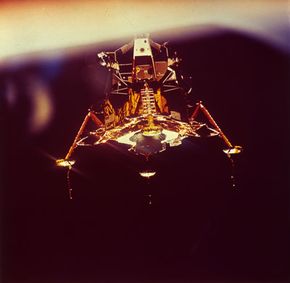Profiles of the Lunar Landing Missions
Lunar spacecraft were made up of two parts. The Command and Service Module carried the crew, operations systems, oxygen, water, fuel and propulsion system. The Lunar Module carried the astronauts to the moon.
These modules were attached to a Saturn V rocket. Powered by liquid hydrogen and as tall as a 36-story building, the Saturn V was made up of three stages. The first stage boosted the rocket through the first 38 miles (61 kilometers) of ascent. The second stage sped the rocket through the upper atmosphere and into the Earth's orbit. The third stage propelled the craft to the moon.
Advertisement
Once under way, the crew separated the Command and Service Module from the third stage and fired its engine. They released the third stage and sped toward the moon. They then turned the module around and docked it nose-to-nose with the Lunar Module.
Once in lunar orbit, the Lunar Module separated from the Command and Service Module and moved in for a moon landing with two astronauts inside. The remaining astronaut stayed behind in the Command and Service Module, orbiting the moon.
The astronauts in the Lunar Module put the engine into full throttle to begin their descent to the moon. More than a dozen small thrust motors helped control the direction and speed of the descent to land the module gently. Because the moon has no atmosphere, the crew members couldn't calculate their altitude and airspeed. The Lunar Module sent out microwave beams to the moon's surface to provide information on the spacecraft's position.
At just a few thousand feet above the moon's surface, a computer onboard the spacecraft initiated the approach phase. The computer needed to adjust both horizontal and vertical speeds to almost zero, while the crew had to adjust for craters and other formations on the moon's surface to avoid crashing.
The Lunar Module commander had the choice of whether to land automatically using the craft's computers, or manually, depending on how clear the landing site was. The pilot had learned how to steer the craft into a landing during simulations on Earth. When the Lunar Module landed, the commander hit the engine-stop button. The craft went into zero-gravity for a second and then the rocket engines on its bottom platform lowered it to the moon's surface.
When the mission was completed, the Lunar Module fired its ascent engine to escape the moon's gravitational pull and lifted off. Because the moon's gravity is lower than that of Earth, the spacecraft had to travel 1.4 miles (2.3 kilometers) per second to escape the moon's atmosphere, compared to the 7 miles per second, or almost 25,000 miles per hour, (11 or 40,233 kilometers, respectively) it had to travel to escape the Earth's atmosphere on the way up.
The Lunar Module docked with the Command and Service module. The two astronauts who had made the landing moved from the Lunar Module to the Command and Service Module with their equipment, and any samples they collected from the moon. They then closed the hatch and released the Lunar Module, sending it crashing back to the moon.
The next challenge was to re-enter Earth's atmosphere without burning up like a meteor. To avoid this, the module was coated in an ablative covering that burned away as it entered Earth's atmosphere and protected the spacecraft underneath from the intense heat.
In the next section, we'll learn about subsequent trips to the moon.
